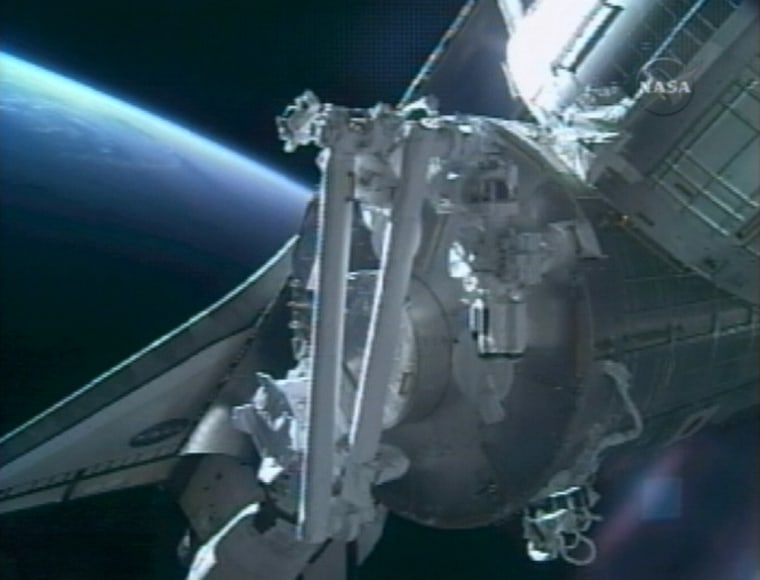The space station’s huge new Japanese lab got even bigger Friday when the astronauts attached an attic to it for extra storage.
The attic — essentially a 14-foot (4-meter) shed, or closet, for spare tools and equipment — was popped atop the 37-foot (11-meter) Kibo science laboratory by astronauts operating the international space station’s robot arm.
Even before Friday’s addition, the billion-dollar, bus-size Kibo was the biggest room at the space station.
The attic had been in a temporary location at the space station since March. There wasn’t enough room on a space shuttle to fit both the attic and lab, so NASA split them into two flights. The third and final Japanese section, a porch for outdoor experiments, will be launched next spring.
“It’s another wonderful day,” said Tetsuro Yokoyama, a Japanese Space Agency deputy manager.
In an interview with The Associated Press on Friday, shuttle Discovery’s commander, Mark Kelly, said Kibo may not smell like a new car, but “it has a new-car feel to it.” Before his flight, he described Kibo as “the Lexus of the space station modules.”
“It’s incredibly big, a lot of room so you have to be a little extra careful. You can get out in the middle of it and you can’t reach a handrail and you could possibly get stuck there for a little while,” Kelly said.
Later in the day, Mission Control informed Kelly that Kibo was looking more like a lab. When the astronauts opened up Kibo on Wednesday, it was empty and provided lots of room for weightless acrobatics.
“I guess there are no more dance parties,” Mission Control said.
Discovery’s astronauts delivered and installed Kibo earlier in the week.
Borscht for Buzz Lightyear?
Also flying to the space station aboard Discovery: a new pump for the space station’s broken toilet, which is now fixed, the jerseys of three sports greats, and Buzz Lightyear.

Buzz joined the 10 astronauts and cosmonauts for dinner on Thursday night — he was offered borscht — and was seen looking out the window at a pair of spacewalkers and ringing the space station’s bell, by banging into it with his head.
The Disney action figure, made famous in the 1995 film “Toy Story,” flew up on Discovery and moved into the space station for a six-month stay, as part of NASA’s toys-in-space educational program.
The jerseys, on the other hand, were kept tucked away in a shuttle locker.
One of Lance Armstrong’s Tour de France yellow shirts is flying, as well as the backup jersey that New York Giants quarterback Eli Manning took to the Super Bowl in February and the last jersey worn by Craig Biggio in a Houston Astros game.
Kelly assured the AP that the shirts will return to Earth unworn, even though several on his crew are big cycling, football and baseball fans.
The astronauts face more work with Kibo on Saturday. They will test-drive the lab’s 33-foot (10-meter) robot arm, which will be used once the Japanese research platform, or porch, arrives next spring.
The third and final spacewalk for Discovery’s nine-day space station visit — to replace an empty nitrogen gas tank — will take place Sunday.
Late Friday, Mission Control asked the astronauts to take some zoom-in digital photos of two thermal protective panels on Discovery’s right wing. Mission Control said embedded sensors had picked up some slight pulses, and while engineers did not think anything was amiss they wanted to make certain.
The astronauts beamed down more than 50 photos of the two wing panels.
The wing sensors are one of NASA’s many safety measures put in place after Columbia was destroyed during re-entry in 2003 because of a gashed wing.
